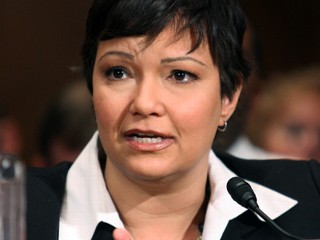
Agricultural News
Fresh Guidance on Clean Water Act- A Clarification or a Power Grab?
Thu, 28 Apr 2011 6:37:07 CDT
 The Obama Administration issued a draft guidance that seeks to clarify exactly which waterways, water bodies and wetlands are covered by the Clean Water Act (CWA). The proposal would expand the number of aquatic areas subject to CWA regulation. We have an audio OVERVIEW of this proposal by the Administration- click on the LISTEN BAR below to hear comments from EPA Administrator Lisa Jackson and USDA Secretary Tom Vilsack.
The Obama Administration issued a draft guidance that seeks to clarify exactly which waterways, water bodies and wetlands are covered by the Clean Water Act (CWA). The proposal would expand the number of aquatic areas subject to CWA regulation. We have an audio OVERVIEW of this proposal by the Administration- click on the LISTEN BAR below to hear comments from EPA Administrator Lisa Jackson and USDA Secretary Tom Vilsack.
"You cannot protect a navigable waterway if all the tributaries to that waterway are unprotected," said Lisa Jackson, administrator of the Environmental Protection Agency. "The question becomes how far upstream is under jurisdiction."
The guidance proposes a biological or chemical connections test on a case-by-case basis between the upstream water body and wetland and the downstream navigable water.
"I do think there'll be some expansion in waters that currently people might view as isolated and when we show that they're connected ecologically, biologically or chemically-it'll be clear that there'll be some increase in jurisdiction. But it's not clear how much," emphasized Jackson, who added that a "few" Prairie Potholes would likely come under federal scrutiny.
"We are very encouraged to see the release of this draft guidance and support the agencies' efforts to restore CWA protections," said Dale Hall, Ducks Unlimited CEO. "While we have not thoroughly analyzed it, we are hopeful the draft guidance will go a long way toward reducing confusion about Clean Water Act administration. Administrative guidance is needed in order to restore protections to many wetlands." These wetland areas include prairie potholes, which are important for maintaining waterfowl populations and the traditions associated with them throughout North America.
The confusion regarding the extent of CWA protections resulted from the decisions of two U.S. Supreme Court cases, SWANCC (2001) and Rapanos (2006). Together, these decisions removed protections for as much as 20 million acres of wetlands, particularly prairie potholes and other seasonal wetlands that EPA and some conservation groups say are esstential to waterfowl populations.
The Chairman of the House Ag Committe, Oklahoma Congressman Frank Lucas says that "This guidance builds a foundation for the EPA and the Army Corps of Engineers to regulate essentially any body of water, such as a farm pond or even a ditch." He adds that "Once again the EPA is trying to broaden its jurisdiction without authority to do so. Changes to the regulatory scheme of the Clean Water Act should be done through notice and rule-making or legislative action. Issuing a guidance document is informal and ambiguous. If this is important to the administration, I urge it to reconsider this approach and move forward with a transparent rule-making process."
Based on the agencies' interpretation of the statute, implementing regulations and relevant caselaw, the following waters are protected by the Clean Water Act:
• Traditional navigable waters;
• Interstate waters;
• Wetlands adjacent to either traditional navigable waters or interstate waters;
• Non-navigable tributaries to traditional navigable waters that are relatively permanent, meaning they contain water at least seasonally; and
• Wetlands that directly abut relatively permanent waters.
In addition, the following waters are protected by the Clean Water Act if a fact-specific analysis determines they have a "significant nexus" to a traditional navigable water or interstate water:
• Tributaries to traditional navigable waters or interstate waters;
• Wetlands adjacent to jurisdictional tributaries to traditional navigable waters or interstate waters; and
• Waters that fall under the "other waters" category of the regulations. The guidance divides these waters into two categories, those that are physically proximate to other jurisdictional waters and those that are not, and discusses how each category should be evaluated.
The following aquatic areas are generally not protected by the Clean Water Act:
• Wet areas that are not tributaries or open waters and do not meet the agencies' regulatory definition of "wetlands";
• Waters excluded from coverage under the CWA by existing regulations;
• Waters that lack a "significant nexus" where one is required for a water to be protected by the CWA;
• Artificially irrigated areas that would revert to upland should irrigation cease;
• Artificial lakes or ponds created by excavating and/or diking dry land and used exclusively for such purposes as stock watering, irrigation, settling basins, or rice growing;
• Artificial reflecting pools or swimming pools created by excavating and/or diking dry land;
• Small ornamental waters created by excavating and/or diking dry land for primarily aesthetic reasons;
• Water-filled depressions created incidental to construction activity;
• Groundwater drained through subsurface drainage systems and
• Erosional features (gullies and rills), and swales and ditches that are not tributaries or wetlands.
Click here for the Obama Administration overview of their idea of improving on Clean Water efforts in America.
WebReadyTM Powered by WireReady® NSI
Top Agricultural News
More Headlines...



















